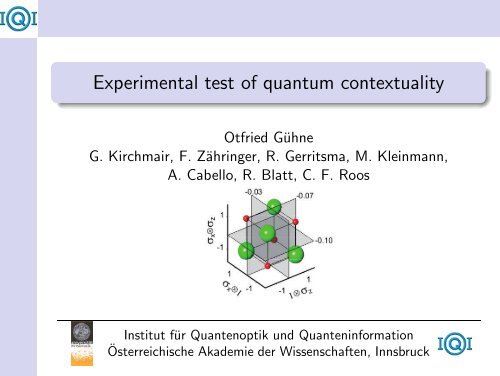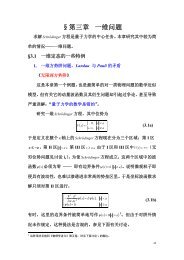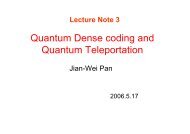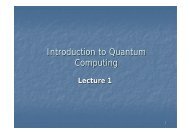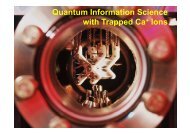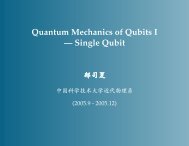Experimental test of quantum contextuality
Experimental test of quantum contextuality
Experimental test of quantum contextuality
- No tags were found...
You also want an ePaper? Increase the reach of your titles
YUMPU automatically turns print PDFs into web optimized ePapers that Google loves.
<strong>Experimental</strong> <strong>test</strong> <strong>of</strong> <strong>quantum</strong> <strong>contextuality</strong>Otfried GühneG. Kirchmair, F. Zähringer, R. Gerritsma, M. Kleinmann,A. Cabello, R. Blatt, C. F. RoosInstitut für Quantenoptik und QuanteninformationÖsterreichische Akademie der Wissenschaften, Innsbruck
Outline1 The Kochen-Specker Theorem and the Mermin-Peres square2 An experimental <strong>test</strong> with trapped ions3 Extended inequalities for <strong>test</strong>ing hidden variable models4 Conclusion & Outlook
Hidden variable modelsEinstein, Podolsky and Rosen’s questionIs <strong>quantum</strong> mechanics complete? Or is there some hidden variable (HV)theory behind it?A. Einstein, B. Podolsky, N. Rosen, Phys. Rev. 47, 777 (1935).Bell’s answerIf a hidden variable model is local, it can be ruled out experimentally.J.S. Bell, Physics 1, 195 (1965); Aspect et al., Phys. Rev. Lett. 47, 460 (1981)Also other models for distant correlations can be ruled out.A. Leggett, Found. Phys. (2003); S. Groeblacher et al, Nature (2007); C. Branciard et al, Nat. Phys. (2008)But what if one has only one <strong>quantum</strong> system?
The Kochen-Specker theoremQuantum mechanics cannot be explainedby non-contextual hidden variable models.E. Specker, Dialectica 14, 239 (1960), J.S. Bell, RMP 38 (1966), S. Kochen, E. Specker, J. Math. Mech. 17 (1967).What does non-<strong>contextuality</strong> mean?
CompatibilityCompatibility <strong>of</strong> measurementsDefinition. Two measurements A and B are called compatible (A ∼ B) ifthey can be measured simultaneously or in any order without disturbance.If a sequence like A 1 B 2 A 3 B 4 A 5 A 6 B 7 ... is measured on a single state,then the values <strong>of</strong> A and B remain the same.Compatibility is experimentally <strong>test</strong>able.In QM: Commuting observables are compatible.This is a pairwise relation, but one can also talk about compatibility<strong>of</strong> three or more observables.
ContextualityNon-contextual theoriesAssume that A ∼ B and A ∼ C. A theory is non-contextual, if it assigns toA a value v(A) independently whether B or C is measured jointly with A.This definition needs at least 3 measurements.B and C don’t have to be compatible.Is this a reasonable assumption about theories ?KS Theorem: Such models are in conflict with <strong>quantum</strong> theoryUsual pro<strong>of</strong>: If |ψ i 〉 form an orthonormal basis, then P i = |ψ i 〉〈ψ i | arecompatible. Non-contextual models have to assign to each P i a value {0, 1}independent <strong>of</strong> the complete basis. On can write down sets <strong>of</strong> bases, suchthat this cannot be done.A. Cabello, Int. J. Quantum Inf. 4, 55 (2006)
The Mermin-Peres squareConsider a four level system (two qubits) and the observables:A = σ z ⊗½, B =½⊗σ z , C = σ z ⊗ σ z ,a =½⊗σ x , b = σ x ⊗½, c = σ x ⊗ σ x ,α = σ z ⊗ σ x , β = σ x ⊗ σ z , γ = σ y ⊗ σ y .The observables in each row (R i ) and column (C j ) commuteand are compatible.If we assign to each <strong>of</strong> them a value v = ±1 independently <strong>of</strong>the row or column, we have3∏R i C i = +1i=1In QM: C 3 = Ccγ = −½, hence ∏ 3i=1 R iC i = −1.A. Peres, Phys. Lett. A 151, 107 (1990); D. Mermin, Phys. Rev. Lett. 65, 3373 (1990).
A <strong>test</strong>able inequalityQuestionCan we translate this into an experimentally <strong>test</strong>able inequality?AnswerConsider sequences <strong>of</strong> measurements. Then, for non-contextual models〈X MP 〉 = 〈A 1 B 2 C 3 〉 + 〈a 1 b 2 c 3 〉 + 〈α 1 β 2 γ 3 〉+〈A 1 a 2 α 3 〉 + 〈B 1 b 2 β 3 〉 − 〈C 1 c 2 γ 3 〉= 〈R 1 〉 + 〈R 2 〉 + 〈R 3 〉 + 〈C 1 〉 + 〈C 2 〉 − 〈C 3 〉 ≤ 4.Here, 〈A 1 B 2 C 3 〉 means the product <strong>of</strong> the values, when the sequenceA 1 B 2 C 3 is measured on a single instance <strong>of</strong> a state.In QM, we have〈X MP 〉 = 6for any <strong>quantum</strong> state (in contrast to a Bell inequality violation).This can be <strong>test</strong>ed in the lab!A. Cabello, PRL 101, 210401 (2008), for other experiments see Y.F. Huang et al, PRL 90, 250401 (2003),Y. Hasegawa et al., 97, 230401 (2006).
The experimental implementation
Non-demolition measurementsProblemMeasurements like σ z ⊗ σ z cannot be implemented by measuring σ z oneach ion, as coherences (like |00〉 + |11〉) would be destroyed.SolutionWrite σ z ⊗ σ z = U nl [½⊗σ z ]U † nland read out only one ion.This needs 6 nonlocal gates for R 3 or C 3 .
Results for the singlet statea b c〈R 1〉 = 0.92(1) 〈R 2〉 = 0.93(1) 〈R 3〉 = 0.90(1)+1+1+1σ z ⊗σ z-1σ x ⊗σ x-1σ y ⊗σ y-1+1Ι ⊗ σ z-1 -1σ z ⊗ Ι+1+1σ x ⊗ Ι-1 -1Ι ⊗ σ x+1+1σ x ⊗ σ z-1 -1+1σ z ⊗ σ xd e f〈C 1〉 = 0.90(1) 〈C 2〉 = 0.89(1) 〈C 3〉 = -0.91(1)σ z ⊗σ x+1-1σ x ⊗σ z+1-1σ y ⊗σ y+1-1+1Ι ⊗ σ x-1 -1σ z ⊗ Ι+1+1σ x ⊗ Ι-1 -1Ι ⊗ σ z+1+1σ x ⊗ σ x-1 -1+1σ z ⊗ σ zIn summary a total value <strong>of</strong> 〈X MP 〉 = 5.46(4) > 4.
Permuting the observables10.950.90.850.80.75row 1 row 2 row 3 column 1 column 2 column 3The order does not really matter, on average 〈X MP 〉 = 5.38
State independenceViolations ranging from 5.23(5) to 5.46(4) for 10 different states.
Consequences and interpretation
What have we shown so far?Conclusion from the experimentNo HV theory which assigns (for a fixed HV λ) ±1 to the measurementsindependently <strong>of</strong> the row or column, can explain the experimental data.But...In the experiment, the observables are not perfectly compatibleSo does one need to assign fixed values ±1?Can we still conclude something about HV models based on some reasonableassumptions?Be careful: HV models without any assumptions can never be refuted!As one can always take the experimental data as a HV model or also Bohmian mechanics.
Generalizing non-<strong>contextuality</strong>Consider a HV model, with HV λ, and a state is effectively aprobability distribution p(λ). Then considerp[(B + 1 |B 1) and (B − 2 |A 1B 2 )]If A and B are compatible and the theory is non-contextualthis is zero.Otherwise, this term quantifies the disturbance <strong>of</strong> B by ameasurement <strong>of</strong> A.This probability is not experimentally accessible.Can we estimate it, if A and B are nearly compatible?
Generalized KS inequalityUsing this assumption, one can show that for a HV model〈X DHV 〉 := 〈A 1 B 2 〉 + 〈C 1 B 2 〉 + 〈A 1 D 2 〉 − 〈C 1 D 2 〉 − 2p err [B 1 A 2 B 3 ]− 2p err [B 1 C 2 B 3 ] − 2p err [D 1 A 2 D 3 ] − 2p err [D 1 C 2 D 3 ]≤ 2with p err [B 1 A 2 B 1 ] = p[B 1 + , B− 3 |B 1A 2 B 3 ] + p[B1 − , B+ 3 |B 1A 2 B 3 ].<strong>Experimental</strong> result<strong>Experimental</strong>ly, one finds〈X DHV 〉 = 2.23(5) > 2⇒ Also more general HV models can be ruled out.In principle, this can be generalized to the full MP square, but then theexperimental precision has to be improved.
ConclusionNon-<strong>contextuality</strong> is in conflict with <strong>quantum</strong> mechanics. Thisconflict is state independent.This contradiction has been investigated using trapped ions.Also some more general HV models have been ruled out.Are the correlations in KS experiments useful for some task?Reference:G. Kirchmair, F. Zähringer, R. Gerritsma, M. Kleinmann, O. Gühne,A. Cabello, R. Blatt, C. F. Roos, arXiv:0904.1655Funding


